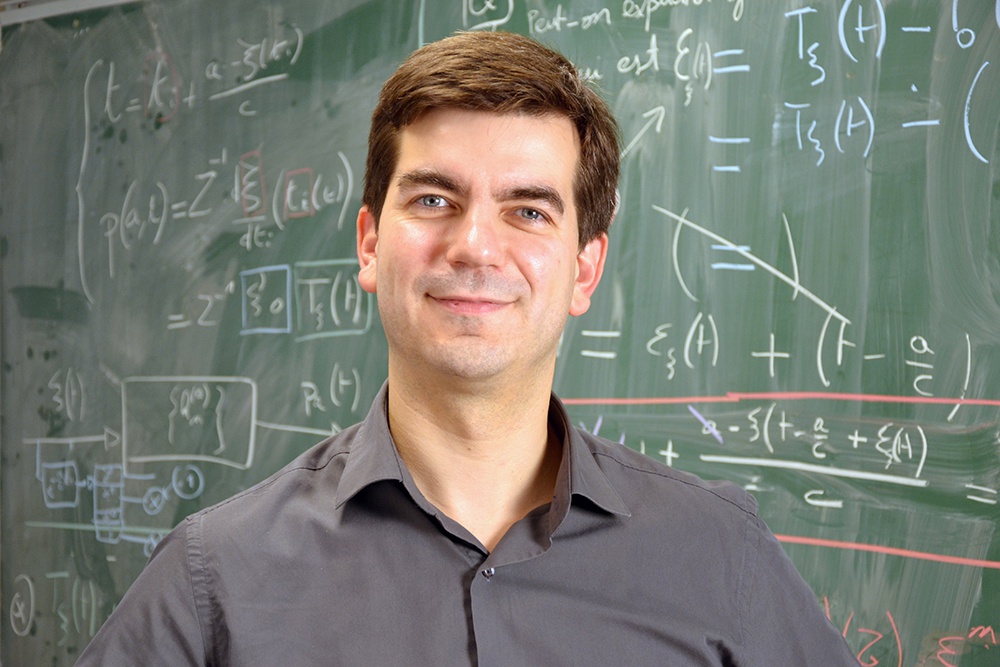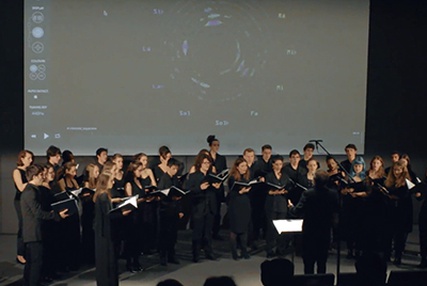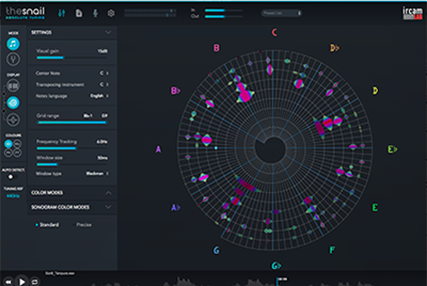Thomas Hélie : "Nous modélisons les instruments, les instrumentistes, et les signaux qu'ils produisent"
Modélisation physique, analyse numérique des sons, caractérisation des signaux : l'équipe "Systèmes et signaux sonores : audio/acoustique, instruments" de l'Ircam décortique les mécanismes de production de sons par tous les types d'instruments, des cuivres aux cordes, en passant par la voix ou les systèmes électroniques.
Votre équipe "Systèmes et signaux sonores : audio/acoustique, instruments" a été créée à l'Ircam en janvier 2017. Quel est son axe directeur ?
Les scientifiques qui étudient les instruments de musique et les sons qu'ils produisent, pour en comprendre le fonctionnement et faire de la synthèse musicale, le font généralement selon deux approches distinctes. Certains s'intéressent aux causes : ils décrivent et modélisent les phénomènes physiques qui règlent les comportements des instruments et de leur couplage avec le musicien. C'est l'approche "systèmes". D'autres s'intéressent plutôt à la structure des sons, sans se préoccuper de leur production. C'est l'approche "signaux". En réalité, il y a des interactions et même une continuité entre ces deux approches, qui faisaient déjà l'objet de travaux à l'Ircam. C'est ce que le laboratoire a décidé de reconnaître et de développer en créant notre équipe.
Quels sont les objectifs de vos travaux ?
Dans le domaine de l'audio et de l'acoustique musicale, une motivation importante est de faire de la synthèse sonore de plus en plus réaliste à partir de la modélisation physique. Quand nous avons un modèle que nous jugeons suffisamment réaliste, nous pouvons proposer des outils d'aide à la facture instrumentale, qui essaient de prédire les conséquences de modifications physiques sur un instrument traditionnel. Nous faisons aussi de la "lutherie virtuelle", en créant sur ordinateur des instruments qui n'existent pas physiquement mais qui respectent les lois physiques. Nous pouvons aussi faire de la lutherie hybride, en ajoutant à des instruments traditionnels des capteurs, des traitements numériques et des actionneurs pour en modifier les sons. Plus généralement, nous travaillons sur le contrôle et la correction de la production sonore des instruments. Les résultats de nos travaux peuvent être utilisés pour la création artistique, ainsi que pour la conservation et la reproduction à l'identique d'instruments anciens. Nous menons aussi des projets à buts pédagogiques, ou encore dans le domaine de la santé, pour ce qui concerne la voix humaine.
De quelles façons étudiez-vous les systèmes sonores ?
D’une part, notre équipe mène des études expérimentales. Pour cela, nous employons des techniques de mesure des vibrations à l'aide de capteurs de précision (lasers, accéléromètres, capteurs de pression, etc.).
Nous développons aussi des systèmes robotisés, qui nous permettent de faire varier des paramètres en continu et de façon reproductible pendant le jeu de l’instrument. Par exemple, nous avons élaboré une bouche artificielle pilotée par des actionneurs, qui inclut des lèvres et est capable de jouer des notes (mais aussi des transitoires ou des régimes complexes) pour les instruments de la famille des cuivres.

Thomas Hélie, chef d'équipe "Systèmes et signaux sonores : audio/acoustique, instruments" de l'Ircam © Deborah Lopatin
Les résultats de ces expériences vous permettent-ils de construire des modèles ?
Plus précisément, ils nous permettent de les valider ou de les améliorer. L'une des grandes difficultés de la modélisation des instruments de musique, c'est que ce sont des systèmes non linéaires : si vous soufflez deux fois plus fort dans une clarinette ou que vous pincez deux fois plus fort une corde de guitare, cela ne produit pas le même son deux fois plus fort, mais plutôt un son différent. En physique, quand nous voulons tenir compte de cette non-linéarité dans les équations, il faut porter une attention toute particulière à garantir la qualité des simulations et éviter certains écueils classiques pouvant aboutir à des comportements aberrants. C'est la raison pour laquelle nous avons introduit dans nos études des cadres théoriques assez généraux. L’un d’eux porte sur la « géométrie différentielle ». L’autre est nommé « systèmes hamiltoniens à ports ». Cela nous permet de modéliser séparément des sous-ensembles, qui obéissent éventuellement à des lois physiques différentes, tout en étant certains que nous pourrons les raccorder pour obtenir un modèle complet réaliste. En particulier, les modèles et les simulations mis au point dans ce cadre respectent le fait que nos systèmes sont passifs. En leur sein, il n'y a pas de création spontanée d'énergie, seulement des transferts.
Pouvez-vous donner des exemples ?
Si l'on considère un tromboniste et son instrument, nous pouvons les modéliser en distinguant la bouche, avec de la mécanique des fluides ; les lèvres, avec de la mécanique des solides déformables ; le jet d'air dans l'embouchure, à nouveau de la mécanique des fluides ; la colonne d'air qui vibre dans le tube, avec de l'acoustique.
Nous avons aussi modélisé dans ce cadre le piano électromécanique Fender-Rhodes : la touche, le marteau et le feutre obéissent à la mécanique des solides ; la barre métallique qui est frappée vibre selon les lois de la mécanique des milieux continus ; la vibration de la barre modifie le champ magnétique d’un système bobine-aimant, c'est de l'électromagnétisme ; et ensuite il faut utiliser des lois de l'électronique pour le haut-parleur, et même de l'acoustique si l'on prend en compte son rayonnement sonore.
Vous cherchez aussi à reproduire certains systèmes physiques sans en connaître les lois : sur quel principe ?
À la jonction de l'approche "systèmes" et de l'approche "signaux", nous mettons au point des « méthodes aveugles » pour modéliser des systèmes sans connaître leur structure interne. Par exemple, comment recopier complètement une pédale d’effet électronique de guitare, ou un amplificateur, simplement en envoyant des signaux d'entrée et en observant les signaux de sortie correspondants ? Quel type de signaux devons-nous utiliser en entrée pour être le plus efficaces et le plus ressemblants possible ? Ces questions sont d’autant plus difficiles quand il faut tenir compte de non-linéarités. Nous avons donc développé l'utilisation de méthodes mathématiques qui non seulement analysent les fréquences des sons à un instant donné, mais capturent aussi les distorsions régulières, avec un effet de mémoire. Ce sont des outils d'analyse des signaux qui permettent de tenir compte de la physique sous-jacente. Nous pouvons ainsi produire une représentation purement "signal" d'un système physique. Lorsque nous faisons de la synthèse, cela nous évite de recalculer en permanence les sons à partir de toutes les équations qui décrivent la physique du système. Sur le plan fondamental, nous sommes aussi intéressés de faire le chemin inverse : retrouver les équations de la physique à partir de l'analyse du signal. C'est encore un problème ouvert.
Vous vous intéressez à la voix humaine : en quoi est-ce un instrument particulier ?
C'est le seul instrument dont tout le monde sait naturellement jouer. Mais c'est aussi l'instrument le plus complexe dans sa constitution et dans ses comportements possibles.
Par exemple, l'excitateur, c'est le larynx, plus précisément les plis vocaux (que l’on appelle souvent « cordes vocales »). Pour mieux comprendre leur fonctionnement, nous collaborons avec un laboratoire grenoblois qui étudie les matériaux et la structure des tissus de ces plis. Du côté du contrôle, il y a plusieurs régimes : la voix normale, la voix de tête, la voix de sifflet ou encore la voix "craquée", très basse. Les transitions entre ces régimes sont des phénomènes complexes. Il reste beaucoup de recherche à faire avant de tout comprendre à propos de la voix, dans son fonctionnement normal, mais aussi bien entendu lorsqu'il y a des pathologies.
Vous avez évoqué des applications pédagogiques de vos travaux. Quelles sont-elles ?
Notre équipe est partie prenante du projet européen iMuSciCA, qui rassemble d'autres partenaires français, mais aussi suisses, espagnols, belges et grecs, et qui a démarré en janvier 2017. L'objectif est de créer de nouvelles méthodologies d’apprentissage à travers de nouveaux outils didactiques dans certains enseignements scientifiques : une approche de découverte et de recherche. Une version adaptée du logiciel Modalys de synthèse sonore par modèles physiques, mis au point depuis plusieurs années à l'Ircam et que notre équipe continue à développer, permettrait à des collégiens ou à des lycéens de créer des instruments de musique virtuels, puis d'en modifier et d'en tester en temps réel des éléments, tels la géométrie ou la nature des matériaux.
Propos recueillis par Luc Allemand




